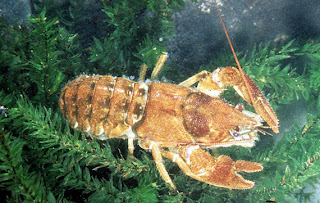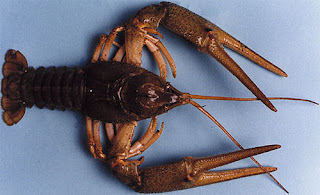Outbreak of crayfish plague
Over recent weeks hundreds of dead crayfish have been seen in the lower River Waveney between Outney Common near Bungay and Beccles. Crayfish plague or another disease is supected as the cause.
Dead crayfish were first noticed by a local farmer in the middle of September and later by anglers. Unfortunately the Environment Agency were not informed until early October when samples were taken and sent for analysis.
The CEFAS (Centre for Environment, Fisheries & Aquaculture Science) lab in Weymouth are analysing the animals to see if they are infected with the highly virulent fungal disease Aphanomyces astaci, commonly known as crayfish plague. Results are expected on Monday October 22nd.
The animals affected are Turkish crayfish – an alien invasive species, which has died in its hundreds over the past few weeks.
However, if the disease spreads to other river systems, the rare native white-clawed crayfish could also be affected and crayfish plague has already wiped out many populations of this species.
The Environment Agency is alerting all anglers, canoeist and other river users to the potential presence of this disease and asking that, as a precaution, they thoroughly clean their equipment before using it in any other waters to stop this disease from spreading once again.
Crayfish in the Waveney belong to a non-native or alien species called Turkish or narrow-clawed crayfish which originates from eastern Europe and western Asia, originally imported to supply the restaurant trade. In common with other European species, this is susceptible to crayfish plague.
Recent surveys showed a dense population in the Waveney present from Flixton to Oulton Broad. The presence of this large species can cause problems such as burrowing into banks, taking anglers bait and preying on river invertebrates and fish eggs. So a thinning or loss of this species from the Waveney is not a problem in itself. However, there is great concern that the plague could spread to other river systems.
This virulent disease has wiped out many populations of our native white-clawed crayfish in England and Wales. Alien crayfish species from America, notably signal crayfish, carry the disease but are not susceptible to it. It is spread by affected crayfish or, more commonly, equipment such as fishing nets, boats etc being transferred from infected waters.
White-clawed crayfish were formerly widespread but have been wiped out from many rivers and now exist in increasingly isolated populations. There is so much concern for the future that it has been designated a Biodiversity Action Plan species as part of the UK’s response to the 1992 Rio Earth Summit and protected by EU legislation (Habitats Directive). Norfolk rivers such as the Wensum, Yare and Stiffkey contain some of the last populations in East Anglia.
The Environment Agency is strongly advising that anyone using equipment in the river take recommended precautions before using the same equipment in any other river system. The stretch of river to be considered potentially affected is anywhere downstream of Homersfield, including Oulton Broad.












